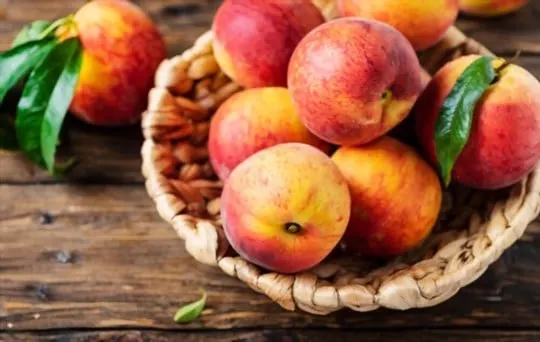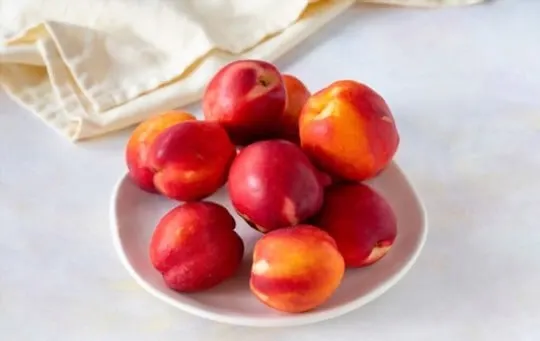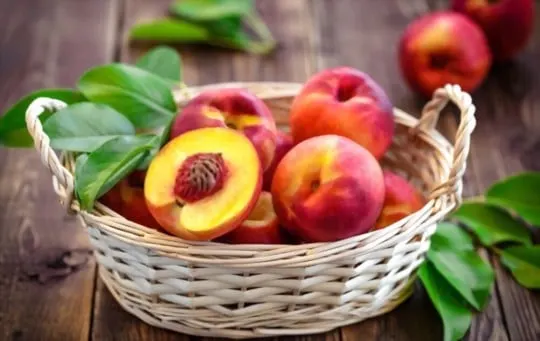There are plums, peaches, and my favorite, nectarines. Their sweet, tangy flavor and lack of fuzz make them my favorite.
Nectarine blossoms are single and white with a faint orange-yellow tint.
The color of nectarine skin varies from yellow to a deep orange color, with darker freckles (lighter spots).
Pits are smaller than peach, round or oval-shaped. The inside flesh is a bit firmer than peach but sweet.
Nectarines can be a refreshing treat on a hot day.
You can just picture the cool, fresh juice pouring down your chin when you take your first bite.
However, I don’t particularly appreciate biting into unripe, hard, or flavorless nectarines.
Many nectarines that I see at my local fruit stand and grocery store aren’t quite ripe.
They are hardy and are still developing their delicious juices.
This article will show you how to tell if a nectarine is ripe and ready for consumption.
I will also discuss how to ripen nectarines to get the sweetest, tastiest fruit possible.
How to Tell if Nectarine is Ripe?

To know how to tell if a nectarine is ripe, you need to know what ripeness looks like.
Ripe fruit or vegetable may exhibit one of these things: color change, texture change, fragrance increase, sugar content increase, and more.
The next time you eat a nectarine or see one in the grocery store, test its ripeness by touching and smelling it.
If your nectarine is ripe, it should have a few of these signs below:
1 – Touch
Your nectarine should feel a bit soft. If it is too hard, it is not ripe yet.
The inner flesh of the nectarine will ripen more as it sits on the counter at room temperature for 2-3 days and up to 7 days if refrigerated after peeling.
A ripe nectarine will give slightly if you gently push on the skin with your fingers.
2 – Smell
If nectarines are ripening, they will smell more fragrant than unripe ones.
A ripe nectarine gives off a sweet scent; when you sniff it, it smells like it is almost rotten but isn’t (like pineapple).
You can also smell the fragrant aroma of nectarines that are on the counter.
3 – Color
Nectarine skin can be yellow to a dark orange color, with some light freckles (lighter spots) scattered.
To tell if your nectarine is ripe, look for these signs: the skin of your fruit becomes less green and is more of a light yellow-orange with a touch of red.
The skin will also begin to wrinkle and become softer, like that of an overripe peach.
4 – Texture
If you press on the nectarine skin, it should feel just a bit soft or even slightly mushy.
If your nectarine is ripe, it will have a bit of giving to it. However, do not use force or push too hard on the fruit.
If your nectarine is ripe, gentle pressure will make it feel just a tad soft.
A ripened nectarine should also have some sticky juices on the stem side of the fruit.
5 – Sugar Content Increasing
As your nectarine ripens, the sugar content will increase. This means the nectarine will be sweeter than it was at first.
Nectarines contain malic acid, which is one of the primary components of tart or sour fruit flavor.
As your nectarine ripens, its amount of sugar increases and its malic acid level decreases, making it sweeter and less sour.
How to Ripen Nectarines at Home?

You might be reluctant to buy nectarines if they are too hard.
There are several easy ways to make nectarines at home:
Place Nectarines on Counter to Ripen
If your nectarine is a bit hard or firm, place it on the countertop at room temperature for 2-3 days.
The fruit will ripen more quickly if you also cover it with a damp paper towel.
It can also sit at room temperature for up to 7 days if you put it in a plastic bag after peeling.
The fruit should increase in sweetness and begin to give off the fragrant aromas of ripeness.
It is possible to speed up the process by placing your nectarines to receive a bit of sun.
It’s important not to let the sunshine too much as it can cause mushy spots.
Using a Paper Bag
You can also store nectarines in a bag made of paper.
As with many fruits, nectarines also produce ethylene gas when they mature.
The gas can be trapped in a paper bag, keeping out moisture and speeding up the process.
The bag can be further accelerated by adding a banana or apple to it.
They emit high levels of natural gas.
Your nectarines should be kept in the bag for 24 hours.
After that, check for softness.
Check again tomorrow if they are not ready.
Wrap in a Napkin
Wrapping your nectarines in a cotton or linen napkin is the final way to ripen them.
Place your fruit stems on the napkin and lay them flat on a smooth surface.
They should be spaced apart so that they don’t touch.
You can place another napkin on top of them, making sure to tuck in the sides to keep air out.
Although this method is more time-consuming, it will yield extra juicy nectarines.
After a few days, you can check the nectarines for softness, freshness, and enjoyment.
Do Nectarines Ripen After Picking?

Although the maturation process will slow down, you can still make nectarines ripen after picking.
This is a great way to help you decide what to do with your nectarines if they are not ready when purchased.
Follow one of the tips mentioned above for ripening your nectarines at home.
If you would like a softer fruit, choose one of the first two methods.
If you are looking for a more intense flavor or juicier nectarine, use the last two suggestions.
Remember to check on your nectarine every 24 hours to see what type of ripening progress is occurring.
When you are ready to enjoy your nectarine, use the tips above for choosing and using them.
How to Store Nectarines – The Right Way?

Based on how you want to use or eat your nectarines, there are many methods for storing them.
For example, if you plan to eat the fruit right away, it can be stored at room temperature in a cool and dry place.
However, if you have too many during the summer season, they can also be stored in the refrigerator for a few days.
If you have ripe nectarines, you can store them in your refrigerator.
It will keep them fresh and juicy for up to one week.
It would be best if you did not put unripe nectarines into the fridge as it may cause them to become mushy when they ripen inside the cold storage unit.
When storing nectarines, it is best to place them in a plastic bag that has been placed into a bowl of water.
You should make sure to take out the bag before storing it, so you do not get any condensation on your fruit.
If you plan to use them for cooking or baking purposes, you can keep them in the fridge for two days.
It is also good to keep nectarines from getting too ripe if you do not plan on eating them to have more uses in your kitchen.
Conclusion
In conclusion, nectarines can be ripened in a few varying methods.
You can use a paper bag, fruit-ripening wrap, or even just by putting them under a towel for seven days after peeling and coring it.
You should check on your nectarine every 24 hours after picking it and do the same if you are trying to ripen it after buying.
Once you have tried all of the methods above, you can eat your nectarine fresh or make some delicious recipes with them and enjoy.
